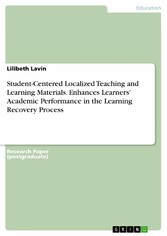Search and Find
Service

Student-Centered Localized Teaching and Learning Materials. Enhances Learners' Academic Performance in the Learning Recovery Process
More of the content

Student-Centered Localized Teaching and Learning Materials. Enhances Learners' Academic Performance in the Learning Recovery Process
Research Paper (postgraduate) from the year 2022 in the subject Pedagogy - School Pedagogics, , language: English, abstract: A student-centered teaching and learning process is essential in all facets of education. Student-centeredness and localization and integration of students' learning preferences are equally important in learners' individual capacities to learn. In an educational learning recovery setting, these approaches are valuable to students' learning. These issues prompted the researchers to assess the effectiveness of student-centered, localized teaching and learning materials in enhancing learners' academic performance, particularly in TLE subjects. The primary goal of this study is to determine the significance of innovative teaching and learning materials in enhancing TLE literacy at Tinurik National High School, Division of Tanauan City, Batangas Province. The study was conducted using a mixed-methods research approach. The research tools used were a questionnaire for a survey and test results. Based on the results of the online survey and the test results of the students, the data was gathered. A Google Form was used to disseminate the online survey to the respondents who were learners. Tests were run both before and after the innovative teaching and learning materials were put into use. To gather sufficient data for the study's goals, the test and questionnaire were created. Through convenience sampling, 153 students total have been selected. To analyze the data, frequencies, percentages, weighted means, correlations, and T-tests were employed.
All prices incl. VAT










